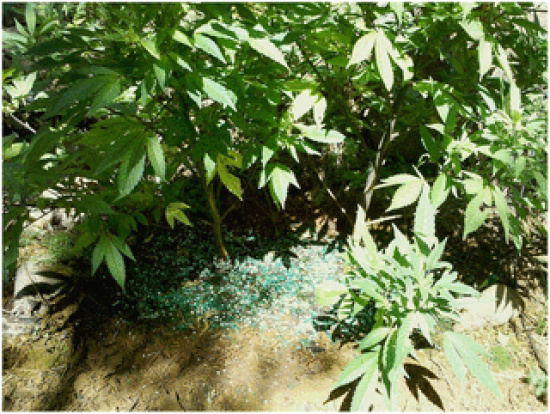
Photo from the Wildlife Conservation Society showing two fisher kits.
Some fishers, candidates for listing under the federal endangered species act, are sickening and even dying because of rat poison. A study published this year points to marijuana grows as a likely source of the rodenticide.

Photo provided by one of the study authors shows a portion of a 2,000 plant marijuana grow. Note the bright green anticoagulant rodenticide pellets (as well as fertilizer) spread at the base. This grow was located here in northern California and within the boundary of the study.
Mourad W. Gabriel, one of the lead authors on the study, explained that in several areas the impacted fishers are being studied from birth to death. Any fishers which die in these areas are carefully tested to determine cause of death. To the surprise of the scientists, many of the animals’ remains showed signs of rodenticide even though they weren’t near areas where there were many humans. In fact, of the 58 carcasses examined, 79% showed exposure to rodenticide.
Many of these fishers, Gabriel believes, are being killed outright from the poison or suffering collateral damage from the poison. He told of one case where a fisher “mother died from predation and, because we are monitoring them through their whole life, we pinpointed the den site.” Hoping to save the kits, the scientists went in. They only found one kit. Sadly, he says, it had already died. This baby which still had its eyes closed was “100% dependent on mother’s milk.” Rodenticide was found in its system which means that the poison transferred either through the placenta or through the milk from the mother.

Photo from the Wildlife Conservation Society showing a kit with eyes still closed.
Gabriel says that there is “zero data on sub-lethal doses” in the second generation rodenticide that the fisher mother and kit were exposed to so the mother may or may not have been experiencing side effects from her poisoning that led to her death from predation. He did say that the earlier, less lethal doses of first generation rodenticides have had some studies done on non-lethal doses. According to Gabriel, when un-dosed rabbits were exposed to a certain level of exposure, 10% died. However, when rabbits were dosed with sub-lethal amounts of the first generation rodenticide, they experienced 40-70% mortality. In the case of the fisher mother’s death by predation, he says, “We can suspect [that there was a correlation] but there is no experimental data to back it up.”
In another case, a female fisher did die as a result of rat poisoning. In this case, her four kits as yet unaffected by the poison died from “starvation and dehydration” before the scientists who were monitoring the mother could find the den and rescue the litter.

A fisher dead of poison at the Sierra Nevada site at which it was found. (Photo from Study)
Gabriel says he and his colleagues have been at “100’s if not 1000’s” of grow sites on public and tribal lands in the last few years. He says they nearly always find rodenticides. At one site he says, “We found 90 pounds… .”
Not only does the rodenticide affect wildlife but Gabriel says it is possible that it could affect humans. “One of the problems,” he says, “is that there is no data. Can these toxicants be sequestered in plants that will be consumed or ingested?” Will this occur in doses high enough to injure humans?
Gabriel is concerned. “This is a sad occurrence what is going on with our public run and tribal lands,” he says. What he doesn’t say, but seems likely to be true, is there is also rodenticides being used in large quantities on private land.
CLICK TO MANAGE